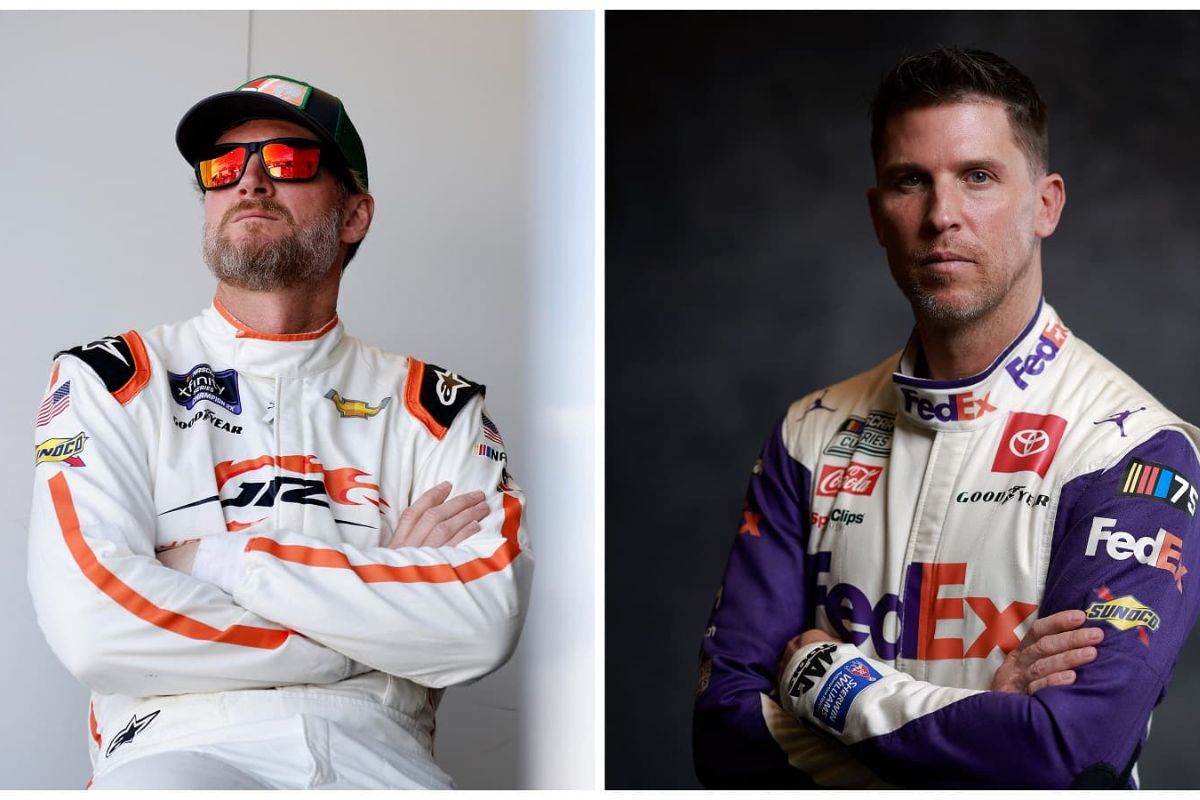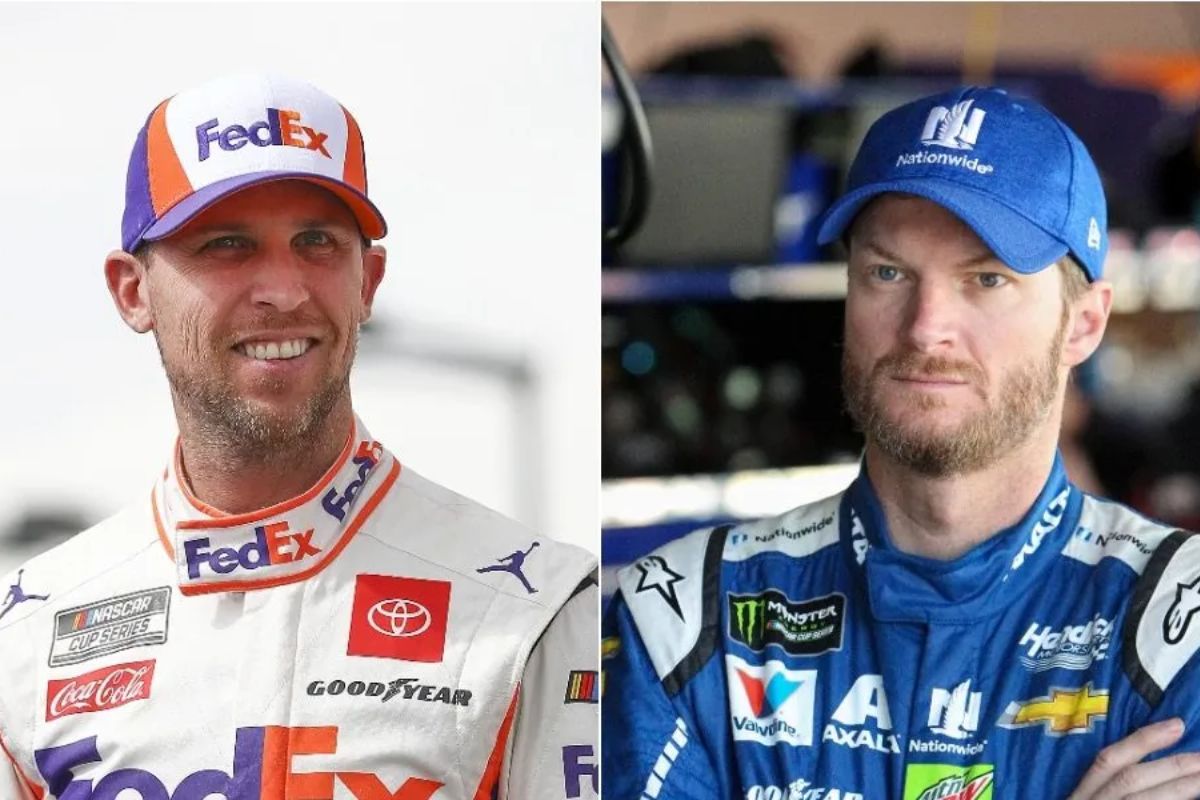Dale Jr Slams Hamlin’s NASCAR Idea: In NASCAR, the recent clash between Dale Earnhardt Jr. and Denny Hamlin over the proposal to shorten race lengths brings to light a deeper discussion on the evolution of the sport. Earnhardt Jr.’s opposition to Hamlin’s suggestion not only shows the emotional and traditional attachments to the race format but also raises pertinent questions about the balance between innovation and preservation. As this debate continues, it is essential to ponder the historical significance of endurance in NASCAR and the potential benefits of adapting to contemporary audience preferences.
Key Takeaways
- Dale Earnhardt Jr. strongly disagrees with Denny Hamlin’s proposed changes to NASCAR races.
- Earnhardt emphasizes the importance of maintaining traditional race lengths for testing endurance and skill.
- He criticizes the idea for potentially oversimplifying race strategies and reducing competitiveness.
- Earnhardt values the historical and cultural aspects of NASCAR, opposing significant alterations.
- He expresses frustration and disappointment with Hamlin’s suggestions, indicating a passionate defense of NASCAR’s legacy.
Current Issues in NASCAR
Several pervasive issues currently plague NASCAR, including the challenges of fuel conservation on superspeedways and insufficient horsepower on short tracks. These problems not only affect the competitiveness and excitement of races but also pose significant strategic dilemmas for teams and drivers.
On superspeedways, the necessity for fuel conservation has introduced a cautious dynamic where drivers often strategize to save fuel rather than compete aggressively. This approach can lead to less engaging races, as drivers may hold back until the final laps. The tension between maintaining high speeds and the need to conserve fuel complicates race strategies, potentially diverting from the spectator experience.
Goodyear’s ongoing experimentation with different tire types aims to address these issues, particularly on short tracks, by improving tire performance to compensate for the horsepower deficit. This initiative reflects a proactive approach to refining the balance between vehicle capabilities and track demands.
Moreover, suggestions like those from Denny Hamlin about shortening races on drafting tracks indicate a recognition of these issues within the racing community. Such proposals highlight the ongoing debate on how best to improve race competitiveness while managing the technical limitations of the vehicles and the strategic complexities they introduce. Balancing these factors is essential for the future health and growth of NASCAR.
Dale Earnhardt Jr.’s Response
In a recent podcast episode, Dale Earnhardt Jr. expressed strong disapproval of Denny Hamlin’s proposal to shorten NASCAR superspeedway races to 400 miles. Dale Jr.’s reaction was instinctive and showed a fundamental disagreement with the notion of reducing race lengths as a means to enrich competition or viewer engagement. His response explored a core aspect of racing culture that values endurance and the thorough test of skill and machinery that longer races represent.
“What NASCAR could do is just take this take the superspeedway races down to 400 miles, and then the stages would probably line up quite a bit better. If a stage was a fuel run, we would never save because we’re always going to fight for stage points.” – (Denny)
Earnhardt articulated his perspective by likening the reduction of race miles to receiving less of something cherished, such as a favorite snack. This analogy serves to highlight the emotional and experiential loss that, in his view, would result from abbreviated races. His argument suggests a reduction not only in the quantity of the sporting event but also in the quality and depth of the race-day experience for all the drivers and fans.
“That’s like giving me less candy bar. That’s like giving me less Tater chips in the bag. You’re pissing me off. Stop it! You know what I’m saying? […] Don’t give me less race. ‘Oh! We don’t like our race, so let’s just do less of it’.” – (Dale Jr.)
Moreover, Dale Jr.’s critique extends beyond personal displeasure, touching on broader implications for race strategy and the intrinsic appeal of NASCAR. The traditional longer format allows for a dynamic interplay of strategic decisions regarding fuel, tires, and pacing, which in his opinion, enriches the competition. Shortening the races could potentially simplify these aspects, thereby diluting the complexity and unpredictability that often lead to thrilling race finishes.

Alternative Solution by Dale Jr.
Exploring alternative solutions, Dale Earnhardt Jr. proposed adding more race stages rather than shortening the complete race length to improve competition without compromising the core of NASCAR events. This approach, he argues, amplifies the race’s entertainment value and strategic complexity without reducing the total racing time cherished by fans.
- Increased Engagement: More stages mean more pivotal moments within a race, keeping fans engaged as drivers and teams adapt their strategies more frequently.
- Augmented Strategy: Teams would need to develop more distinct strategies, balancing between short-term gains at each stage end and the overall race outcome. This could lead to more dynamic races with frequent lead changes.
- Fair Competition: Shorter stages could potentially level the playing field, as teams would have less time to distance themselves from the pack within each segment, thereby keeping the competition tight until the final laps.
- Economic Impact: More stages could lead to increased sponsorship opportunities, as brands could sponsor individual stages, thus driving up the commercial value of races.
“That’s a way to get that but I don’t think I want to have a shorten the race? Why don’t you just put enough stages in there to get that solution that you want to. […] so just add another stage don’t take away racing don’t take don’t you just said you don’t want to add another stage well don’t if you’re giving me the choice between taking away candy bar shortening up my candy bar right or taking chips out of the bag versus adding another stage, I’m gonna say just add the f*cking stage man. I don’t want less racing okay I don’t want less racing.” – (Dale Jr.)
Rodney Childers of Stewart-Haas Racing supports this notion, suggesting that shorter stages could eliminate strategies like fuel saving, which often detract from the racing action. By adjusting stage lengths, NASCAR could foster a more active racing environment where strategic tactics and driver skills are at the forefront, possibly increasing viewer satisfaction and broadening NASCAR’s appeal. These considerations suggest that Dale Jr.’s proposal could indeed be a viable alternative to shortening races, aligning with the preferences of many stakeholders in the sport.
“If the stages were 40 laps instead of 60 laps, there wouldn’t be any fuel saving. So, if you had two 40s and whatever else or however you want to split it up” – (Rodney)
Current Race Format Challenges
In a surprising twist that might just favor Denny Hamlin, the upcoming Coke Zero 400 is shaking up the usual race dynamics. Typically, at superspeedways like Daytona and Talladega, fuel lasts for around 40-45 laps. This means that stages should ideally be around 40 laps or shorter so drivers can complete them without refueling. However, the Coke Zero 400 is deviating from the norm. The first stage will be 35 laps, falling under the fuel run limit. This means drivers won’t need to worry about saving fuel early on. But here’s where it gets interesting: the second stage will be a hefty 60 laps, followed by a final 65-lap dash. With the next two stages requiring at least one pit stop, it’s setting the stage for some intense strategy and exciting racing action, especially with Denny Hamlin potentially in the spotlight.
Despite Denny Hamlin’s suggestion to shorten races, it’s not as straightforward as it seems. Dividing a race into three parts, each short enough to avoid refueling, presents a challenge. As long as there’s a pit stop required before a stage ends or the race concludes, drivers will still have a reason to save fuel. This keeps strategy and fuel management alive, adding complexity and excitement to the races.
Even if stage breaks were eliminated, the fuel-saving game would persist. Drivers would simply focus on minimizing their final pit stop or attempting to finish with fewer pit stops overall. It’s all about finding the most efficient strategy to gain an advantage on the track. So, regardless of the format, fuel management remains a key factor in NASCAR racing, keeping fans on the edge of their seats until the very end.
Alternative Strategies
One potential avenue for NASCAR to explore is rethinking tire strategy, particularly at tracks like Daytona and Talladega. If tires wore out more quickly, teams would be forced to make more frequent pit stops, which could reduce the prevalence of quick splash-and-go stops solely for track position. Currently, Goodyear is already occupied with adjustments for short tracks, so expecting them to address all the issues in NASCAR might be a bit overwhelming. However, reconsidering tire specifications could be a step in the right direction toward enhancing competition and strategy on the track.
Rodney Childers on the fuel saving and maybe adding another stage to superspeedway races because that's the only solution if this isn't tenable. pic.twitter.com/z9bV4NSV2R
— Matt Weaver (@MattWeaverRA) April 21, 2024
- Draft Minimum Speed Requirement: Setting a minimum speed for drafting could discourage drivers from overly conservative racing. If a driver’s lap times fall below a certain threshold (e.g., 54 seconds at superspeedways), they would no longer be scored. This rule would push drivers to maintain competitive speeds, enhancing the pace of the race.
- Team Collaboration Strategies: Encouraging smaller teams to collaborate could alter race dynamics significantly. For instance, if teams like Live Fast Motorsports and Beard Motorsports work together to maintain a high pace, they could strategically influence the race outcome, challenging larger teams to respond.
With a pace five seconds quicker per lap, leading drivers could lap the entire field in just about 10 laps. In a 60-lap stage, that means they could potentially put everyone else a lap down. It’s a scenario that puts pressure on the trailing pack to increase their speed, ultimately emphasizing the competitive essence of racing. It’s about pushing boundaries and ensuring that every competitor is challenged to perform at their best, keeping the excitement levels high for fans and drivers.
News in Brief: Dale Jr Slams Hamlin’s NASCAR Idea
The debate surrounding the duration of NASCAR races highlights a critical tension between tradition and innovation within the sport.
Dale Earnhardt Jr.’s firm defense of the current race format shows the value placed on endurance and strategic complexity that are fundamental to NASCAR’s identity.
This perspective not only challenges proposals for shorter races but also emphasizes the importance of maintaining the sport’s heritage and the rigorous tests of skill it offers to participants.
Our Reader’s Queries
Q. Did Dale Earnhardt Jr ever won a NASCAR championship?
A. Earnhardt has clinched NASCAR playoff berths on eight occasions: in 2004, 2006, 2008, 2011, 2012, 2013, 2014, and 2015. Notably, he stands as the lone third-generation NASCAR champion, securing back-to-back NASCAR Xfinity Series titles in 1998 and 1999.
Q. When was Denny Hamlin’s rookie year in the Cup series?
A. Hamlin entered the NASCAR Cup Series scene in 2005 at Kansas Speedway under the banner of Joe Gibbs Racing (JGR). He acknowledges J.D. Gibbs, as depicted in a 2009 image, for providing him with his inaugural opportunity at the esteemed team.
Q. Why is Dale Earnhardt Jr so popular?
A. Earnhardt’s impressive track record at Daytona International Speedway led to his moniker, the “Pied Piper of Daytona.” He boasts two victories at the Daytona 500, clinching the prestigious title in 2004 and 2014. Additionally, he holds the remarkable achievement of winning the Most Popular Driver Award for fifteen consecutive years, from 2003 to 2017.
Q. Has Denny Hamlin won a cup?
A. Hamlin holds the record for the most victories in the NASCAR Cup Series without clinching a championship. Despite falling short of the coveted title, he has consistently emerged as a top contender for the championship throughout his career.
ALSO READ: Dale Earnhardt Jr.’s Tech Masterstroke: Elevating NASCAR’s Roots!


